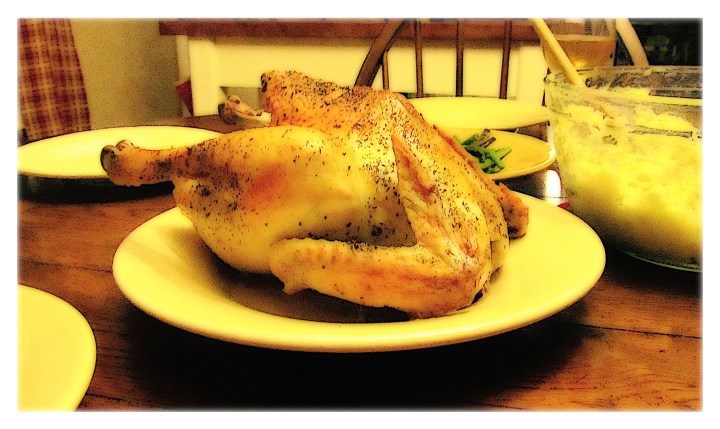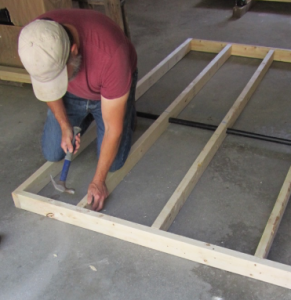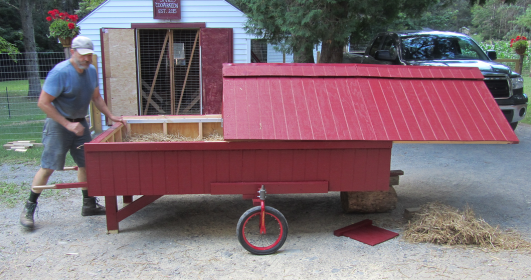A couple of weeks ago, I wrote about my anxiety surrounding our first “one bad day” as farmers. We had 14 chickens to process, and I had never experienced anything like it before. For me, it was a tough day. A long day. A draining day—and my husband did most of the work.
Still, that one bad day was profound for me, but I wanted to share my husband’s perspective with my readers because he bears the brunt of our farming endeavors so much more than I do. I invited him back for a guest blog post, and he writes about why we do what we do here.
We live in a world where most of us buy our lives from one store or another—the grocery store, the big-box, the mall conglomerate—ready-made and processed by others. Our appetites and desires are crafted and subtly honed; our satiation is often artificial and, at best, temporary, at worst potentially harmful. It is perfectly acceptable to mislead, obfuscate, and flat-out lie in this world. Television commercials, product labels and politicians do it all the time. Our truths are processed for us. The effectiveness of fact-checkers, like weather-forecasters, is subject to the winds.
Truth seemed different when I was young. When I was a boy, I had a step-grandmother. She kept a hatchet; the wooden handle was smooth and polished, and the edge on the head invariably was sharp enough to slice paper. We kept chickens; she came to help butcher the cockerels and old laying hens—she was a tough old bird herself. She would catch a chicken, grab it by the legs, flip it upside down, hold it until it settled, then lay it across the chopping block and whack! Her hatchet flashed like a guillotine. Sometimes, a headless bird would spring up and run, spewing blood around the yard, seemingly unwilling to accept the hardest of truths.
My step-grandmother was not a nurturing woman, but she was particularly grim on the days she butchered. She had no time for a foolish boy, and I did not understand her shortness. It took me many years to fully comprehend.
I left that world as an adult; I became busy, like most, with modern life and all its fixtures and conveniences. I moved with the times. But gradually, persistently, I started paying attention to where exactly “the times” where taking me. Terms like pesticides, preservatives, and factory farms began picking at the margins of my attention. I began to question the costs of my convenience, and with my wife, began to examine the modern truths.
We decided we no longer wanted to support agricultural systems designed around convenience for profit, where animals are abused and foods are poisoned with pesticides. We no longer wanted to support a food industry whose colorful and elaborate claims of health and nutrition form the foundational architecture for products propped up by preservatives and additives. So, as much as we could, we deliberately and steadily began moving away from this modern version of the truth.
We started with a garden. Each year we worked it, the area we planted grew—along with our vegetables—and our reliance upon the grocery store diminished. Three years after we started gardening, we bought chicks—Rhode Island Reds (stalwart layers)—and we began to collect eggs. My wife previously had insisted on buying eggs from cage free, humanely raised chickens. Having our own was a substantial cost savings. A year into raising laying hens, and subsequently increasing our flock with the addition of ISA Browns (the little French maids of laying hens), we bought a flock of Freedom Rangers—a type of broiler chicken.
Broiler chickens are also known by the anti-euphemism “meat-birds,” which is a truth that isn’t processed.
Ironically, the first batch of broilers were the friendliest chickens to date. I initially housed them in our garage in a brood-box I had fabricated out of scrap wood and old, closet doors. They quickly outgrew this arrangement, and I extended their garage area with a pallet enclosure bedded with straw. During this time, I also built a mobile chicken coop (not out of scrap wood and closet doors). I had it finished when the broilers were almost a month old and ready to move outside.
I wanted to keep them separate from the main flock, so I fenced an area approximately 1250 square feet about 50 feet from our back door, and I moved the broilers and their coop into it. There was some initial trepidation and some awkwardness among the fourteen young birds. The contrast between blue sky and 8-foot garage ceiling must have been somewhere north of tremendous. And the coop, being two-and-a-half feet off the ground, made for some precarious, initial forays down the ramp into the new world. Still, it didn’t take long before the fourteen were scratching and pecking and having their little chest-bumping show-downs over the new territory.

We had deliberately attempted to humanize the Reds and Browns. But we did not with the Rangers, for obvious reasons. Despite this, the Rangers regularly crowded the fence whenever one of us came out the back door. I could walk among them without having them shy away as the Reds and Browns tended to. They often came to me instead, and I found, I could pet many of them if I wanted. This was before the treats started pouring out the back door.
Freedom Rangers finish in about 80 days, unlike the Cornish Cross broilers, which reach maturity in six to eight weeks and do little more than eat and excrete. The Rangers lead more of a “normal” chicken life, and I have read, taste better for it. The flip-side—in 80 days, I got to know them.
They were ready in mid-September, a few days before my birthday. I decided I would take care of business the weekend after. But I didn’t. I kept finding other, more urgent things to do, and it wasn’t until the morning of the 25th that I finally settled in to the task. I thought about my step-grandmother that day.
Like her, I am now a chicken serial killer. I slaughtered the fourteen—one after another. I held them by their feet, placed them in the killing cone, cut their jugulars, and then quickly pushed a knife through their palates into their brains. Each went instantly limp. It was one bad day for those chickens and one of many bad days for me. But there is truth in it.

It was late in the day when I asked my seven-year-old son to catch the final bird, which he did, his first involvement. He chased her around the pen then solemnly brought her to me. We talked over that final chicken, and he understood we should be grateful for, and respectful of, her sacrifice. We thanked her, as I had for each, and I explained that chickens do not have much of an opportunity to affect positive change in this world, but that he did. And she would help nourish him on his journey toward becoming a good man. There is truth in that too.







